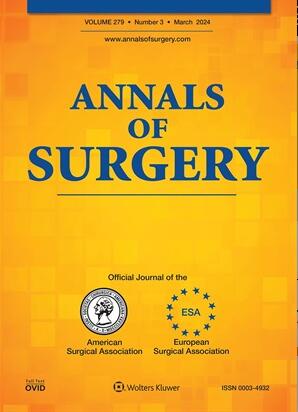Perioperative Outcomes in Open Versus Minimally Invasive Gastrectomy For Gastric Cancer: A European Multicenter Study Based on the GASTRODATA Registry.
IF 6.4
1区 医学
Q1 SURGERY
引用次数: 0
Abstract
OBJECTIVE To evaluate morbidity and mortality after minimally invasive (MIG) versus open gastrectomy (OG) for gastric cancer (GC) in a large European population, with a subgroup analysis comparing total and subtotal gastrectomy. SUMMARY BACKGROUND DATA Real-world European studies comparing postoperative outcomes between MIG and OG are lacking. METHODS This retrospective study included GC patients undergoing curative-intent gastrectomy between 2017 and 2021 at 24 high-volume European centers participating in the GASTRODATA registry. The primary outcome was the perioperative complication rate after MIG versus OG. Propensity score matching (PSM) was performed to adjust for potential confounders. RESULTS Of 2430 patients, 1,800 (74%) underwent OG and 630 (26%) MIG. MIG was performed in patients with smaller tumors, earlier stages, and less frequently receiving neoadjuvant treatment (P<0.001). MIG was associated with higher R0 resection rate (96.5% vs. 92.4% in OG), shorter hospital stay, lower perioperative complication rate (23.0% vs. 31.6%, P<0.001), and reduced 30-day and 90-day mortality rates (1.6% vs. 3.3%, [P=0.026] and 1.9% vs. 4.7%, [P=0.001], respectively). In sub-group analysis, MIG had fewer perioperative complications in subtotal (17.9% vs. 25.3%, P=0.005), but not total gastrectomy (31.5% vs. 36.1%, P=0.201). After PSM, MIG remaind significantly associated with lower perioperative complication rates compared to OG only in subtotal (OR=0.49, 95% CI, 0.30-0.80; P=0.005), but not in total gastrectomy (OR=1.15, 95% CI, 0.62-2.17; P=0.645). CONCLUSIONS Minimally invasive subtotal gastrectomy was associated with fewer perioperative complications than OG, while this association was not observed for total gastrectomy. Minimally invasive subtotal gastrectomy should be considered a viable option in specialized European centers.基于GASTRODATA注册的欧洲多中心研究:开放式与微创胃切除术治疗胃癌的围手术期预后
目的:通过亚组分析比较全胃切除术和次全胃切除术,评估欧洲大量人群胃癌(GC)微创(MIG)与开放式胃切除术(OG)的发病率和死亡率。欧洲缺乏比较MIG和OG术后结果的研究。方法:本回顾性研究纳入了2017年至2021年间在24个参与GASTRODATA注册的欧洲大容量中心接受治愈性胃切除术的胃癌患者。主要观察指标是MIG与OG术后围手术期并发症发生率。采用倾向评分匹配(PSM)来调整潜在的混杂因素。结果2430例患者中,1800例(74%)行OG, 630例(26%)行MIG。MIG适用于肿瘤较小、分期较早、接受新辅助治疗较少的患者(P<0.001)。MIG组R0切除率较高(96.5% vs. OG组92.4%),住院时间较短,围手术期并发症发生率较低(23.0% vs. 31.6%, P<0.001), 30天和90天死亡率降低(1.6% vs. 3.3%, [P=0.026], 1.9% vs. 4.7%, [P=0.001])。亚组分析中,MIG的围手术期并发症总发生率较低(17.9%比25.3%,P=0.005),而全胃切除术的围手术期并发症发生率较低(31.5%比36.1%,P=0.201)。PSM后,与OG相比,MIG的围手术期并发症发生率仍显著降低(OR=0.49, 95% CI, 0.30-0.80;P=0.005),但在全胃切除术中没有(OR=1.15, 95% CI, 0.62-2.17;P = 0.645)。结论微创胃次全切除术围手术期并发症较OG少,而全胃切除术无此相关性。微创胃大部切除术应被认为是欧洲专业中心可行的选择。
本文章由计算机程序翻译,如有差异,请以英文原文为准。
求助全文
约1分钟内获得全文
求助全文
来源期刊

Annals of surgery
医学-外科
CiteScore
14.40
自引率
4.40%
发文量
687
审稿时长
4 months
期刊介绍:
The Annals of Surgery is a renowned surgery journal, recognized globally for its extensive scholarly references. It serves as a valuable resource for the international medical community by disseminating knowledge regarding important developments in surgical science and practice. Surgeons regularly turn to the Annals of Surgery to stay updated on innovative practices and techniques. The journal also offers special editorial features such as "Advances in Surgical Technique," offering timely coverage of ongoing clinical issues. Additionally, the journal publishes monthly review articles that address the latest concerns in surgical practice.
 求助内容:
求助内容: 应助结果提醒方式:
应助结果提醒方式:


